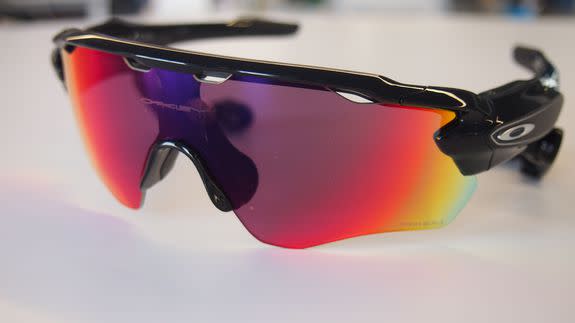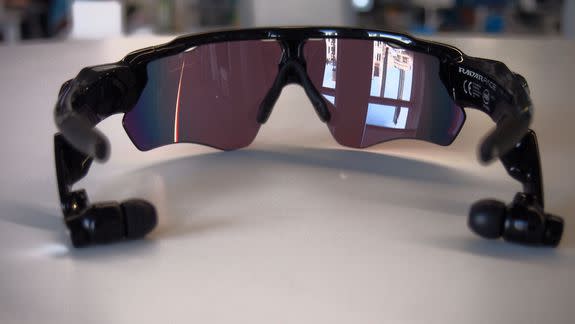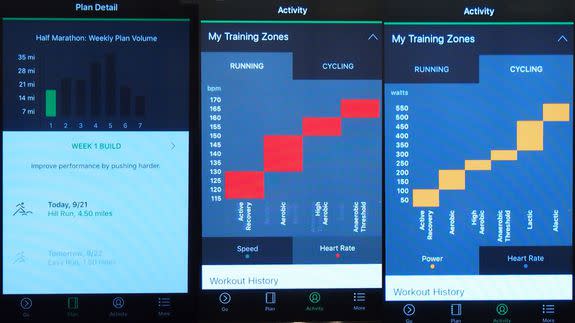Up close with Oakley Radar Pace, the wearable that may help you forget Google Glass

Wearing Google Glass was probably never cool, but that doesn’t mean eyewear can’t still be both intelligent and hip. At least that’s what sunglass manufacturer Oakley is counting on.
Nine months after Intel — Oakley’s partner — gave us a brief glimpse of the future of intelligent eyewear, Oakley is finally ready to ship the sharp-looking Oakley Radar Pace.

Image: lance ulanoff/mashable
Like Google Glass before it, these $449 sunglasses feature a ton of technology that’s built directly into the frame. Unlike Glass, these frames feel lightweight and, at a glance, still look like normal eyewear.
Where Google Glass sought to invent a new platform for delivering real-time information, Oakley Pace Radar’s goals are somewhat narrower — real-time sport and fitness training feedback and guidance — and, as a result, the technology may be more accessible.
Inside your eyewear
Built into each pair is a collection of sensors that include an accelerometer, gyroscope and barometer, and sensors for humidity and proximity. There are also a pair of removable earphones that fold down from the Oakley Radar Pace’s temples (the stems that extend from the hinges to over your ears) and a trio of microphones to help the sunglasses hear you even in challenging audio situations.

Image: LANCE ULANOFF/MASHABLE
Those microphones are backed by Intel’s Real Audio technology, a natural language processing system that can respond to commands and questions, and follow context.
In the demonstration I saw, an Oakley runner started by asking the system which workout he was doing today. It told him he was supposed to run 4.5 miles and climb 150 feet, essentially a hill run. Once he was on the treadmill, he asked about his current heart rate. The Oakley Radar Pace system responded with the beats per minute measurement. Picking up his pace, the runner then asked “How about now?” and Intel’s Real Audio knew he was still talking about his heart rate. At launch, the system will understand English, Italian, German, Spanish and French.
Sometimes, when the runner wanted to talk to the Radar Pace sunglasses, he touched the earphones and said, “OK, Radar.” Perhaps not coincidentally, the system can also be used to communicate with other digital assistants, including Apple’s Siri and Google Assistant.

Image: LANCE ULANOFF/MASHABLE
The hardware is paired with an app. Like most workout apps, you start by entering your key metrics: gender, age, height, weight and then some details about your workout goals. The app is designed to learn from each workout and make adjustments to your regimen accordingly.
Together with the sunglasses, the system acts as a real-time trainer, answering your questions about your current stats and also encouraging you to adjust when it thinks you’re not achieving your workout goals. During my demo, the Oakley runner was hitting a stride rate of about 82 strides per minute. The app encouraged him to pick up his pace to 88.
The runner didn’t have to touch the earphones or sunglasses to engage with the Radar Pace. He just spoke. Oakley execs told me this is preferable to glancing down at a wrist-worn device, which can throw off an athlete’s technique.
What’s behind the Intel Real Audio remains a bit of a mystery. When I asked what Intel chip was inside, the Intel representative would only say that it’s an embedded system with natural language processing.
This is not Oakley’s first foray into audio-enabled sunglasses. Back in 2010, it introduced its Thump MP3 sunglasses. Like those, the Oakley Radar Pace can play music from your Bluetooth-connected phone. It even includes touch sensitive controls, which you can use to access music and talk to Intel Real Audio.
For all the built-in technology and sensors, the Radar Pace lacks a heart rate monitor, which means that, if you want to track that key workout metric, you’ll need to wear and connect to a third party device. Oakley execs told me the Radar Pace will work with most Bluetooth Low Energy heart rate monitors, which should cover a lot of popular wrist-worn devices. However, the Apple Watch is, for now, not one of them. It’s also not clear at the moment how the sunglasses will integrate, if at all, with third-party workout apps.
Battery life is currently rated at 4 hours with music playing and 6 hours without.
These are not your father's @oakley sunglasses. These listen and talk to you. More to come. pic.twitter.com/NUTYTsTpj8
— Lance Ulanoff (@LanceUlanoff) September 21, 2016
Based on what I saw in my demonstration, the Oakley Radar Pace looks promising. It’s stylish, light, comfortable (as long as you don’t wear glasses, since it won’t work with them), and offers swappable lenses (you can buy different Oakley Prism lenses for filtering out and enhancing different colors, depending on your sport). Plus, it’s unlikely anyone will call you a "Radar Pace-hole" when you wear them.
They arrive in stores on Oct. 1. Stay tuned for Mashable’s full review.

 Yahoo News
Yahoo News 